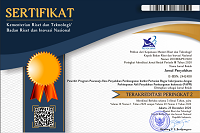MODEL KETAHANAN KELOMPOK TANI PADA WILAYAH DAN KOMODITAS YANG BERBEDA DI JAWA
Keywords:
Model, Group Security, Area, Commodity
Abstract
The Green Revolutions failure caused many farmer groups to cease their activities, even though they had to fulfill many needs. This situation created a need to develop a model for group survival. With those afore mentioned background, this research was conducted. Data was collected in September and October 2005 involving rice, soybean, corn and vegetables farmer groups in the east, central and west Java. The research findings pointed out that there was a relationship between the group survival and their adaptation, goal attainment, integration and latency functions. The group survival rates were higher in central and east Java than in west Java. Additionally, the vegetable and rice farmer group survival rates were higher than the soybean and corn farmer groups. The adaptation, the goal attainment and the integration functions were more strategic for farmer groups in the west and east Java and also for vegetable farmer groups such as soybean and corn group wereas the strategic function were adaptation and integration.Downloads
Download data is not yet available.
Published
2006-06-01
How to Cite
UchrowiZ., JahiA., SanimB., & SumardjoS. (2006). MODEL KETAHANAN KELOMPOK TANI PADA WILAYAH DAN KOMODITAS YANG BERBEDA DI JAWA. Jurnal Penyuluhan, 2(2). https://doi.org/10.25015/penyuluhan.v2i2.2123
Section
Articles
Authors who publish with this journal agree to the following terms:
- Authors retain copyright and grant the journal right of first publication with the work simultaneously licensed under a

This work is licensed under a Creative Commons Attribution 4.0 International License that allows others to share the work with an acknowledgement of the work's authorship and initial publication in this journal. - Authors are able to enter into separate, additional contractual arrangements for the non-exclusive distribution of the journal's published version of the work (e.g., post it to an institutional repository or publish it in a book), with an acknowledgement of its initial publication in this journal.
- Authors are permitted and encouraged to post their work online (e.g., in institutional repositories or on their website) prior to and during the submission process, as it can lead to productive exchanges, as well as earlier and greater citation of published work (See The Effect of Open Access).















